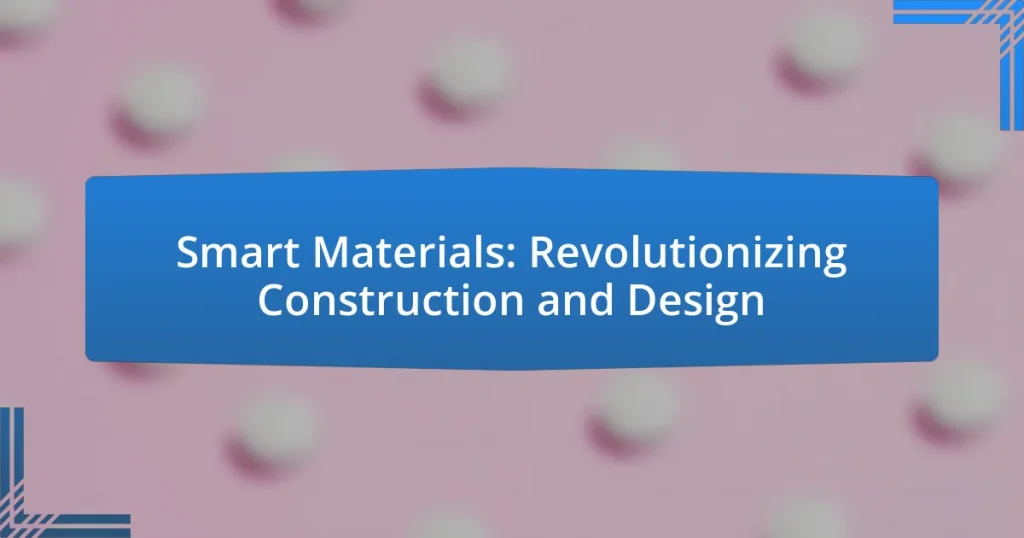Smart materials are innovative materials that dynamically respond to external stimuli such as temperature, pressure, and moisture, making them essential in modern construction and design. This article explores the distinct properties of smart materials, including shape memory alloys and piezoelectric materials, and their applications in enhancing structural integrity, energy efficiency, and sustainability. It also addresses the challenges faced in their adoption, such as high costs and technical limitations, while highlighting future trends and best practices for integrating these materials into architectural projects. The discussion emphasizes the transformative potential of smart materials in revolutionizing construction practices and urban design.

What are Smart Materials?
Smart materials are materials that can respond dynamically to external stimuli, such as temperature, pressure, moisture, or electric fields. These materials exhibit properties that change in a predictable manner when subjected to these stimuli, enabling applications in various fields, including construction and design. For instance, shape memory alloys can return to a predetermined shape when heated, while piezoelectric materials generate an electric charge in response to mechanical stress. The versatility and adaptability of smart materials make them essential in innovative construction techniques and design solutions, enhancing functionality and efficiency.
How do Smart Materials differ from traditional materials?
Smart materials differ from traditional materials in that they can respond dynamically to external stimuli, such as temperature, pressure, or electric fields. Traditional materials, like metals and plastics, maintain fixed properties and do not adapt to changes in their environment. For example, shape-memory alloys can return to a predetermined shape when heated, demonstrating a level of functionality that traditional materials lack. This adaptability allows smart materials to be utilized in innovative applications, such as self-healing structures and responsive design elements, which enhance performance and efficiency in construction and design.
What properties define Smart Materials?
Smart materials are defined by their ability to respond dynamically to external stimuli, such as temperature, pressure, moisture, and electric or magnetic fields. These materials exhibit properties like shape memory, self-healing, and piezoelectricity, which enable them to change their physical or chemical properties in a controlled manner. For instance, shape memory alloys can return to a predetermined shape when heated, demonstrating their adaptability. Additionally, piezoelectric materials generate an electric charge in response to mechanical stress, making them useful in sensors and actuators. These properties allow smart materials to enhance functionality and efficiency in various applications, particularly in construction and design, where adaptability and responsiveness are crucial.
How do Smart Materials respond to environmental changes?
Smart materials respond to environmental changes by altering their properties, such as shape, stiffness, or conductivity, in reaction to external stimuli like temperature, humidity, or electric fields. For instance, shape memory alloys can return to a predetermined shape when heated, demonstrating a direct response to temperature changes. Additionally, piezoelectric materials generate an electric charge in response to mechanical stress, showcasing their adaptability to physical forces. These responsive behaviors are utilized in various applications, including self-healing structures and adaptive building facades, enhancing functionality and efficiency in construction and design.
What are the types of Smart Materials?
Smart materials can be categorized into several types, including shape memory alloys, piezoelectric materials, thermochromic materials, and electrochromic materials. Shape memory alloys, such as Nitinol, can return to a predetermined shape when heated, making them useful in applications like medical devices. Piezoelectric materials generate an electric charge in response to mechanical stress, which is utilized in sensors and actuators. Thermochromic materials change color in response to temperature variations, often used in temperature-sensitive applications. Electrochromic materials alter their color or transparency when an electric voltage is applied, commonly found in smart windows. These classifications highlight the diverse functionalities and applications of smart materials in various fields, including construction and design.
What are shape memory alloys and how do they work?
Shape memory alloys (SMAs) are metallic materials that can return to a predetermined shape when heated above a specific temperature. This unique property arises from a phase transformation between two solid phases: the martensite phase, which is stable at lower temperatures, and the austenite phase, which is stable at higher temperatures. When an SMA is deformed in its martensite state, it can be restored to its original shape upon heating, due to the rearrangement of atoms during the phase change. This behavior has been extensively studied and utilized in various applications, including actuators, medical devices, and robotics, demonstrating their versatility and effectiveness in smart material technologies.
What role do piezoelectric materials play in construction?
Piezoelectric materials play a crucial role in construction by enabling the conversion of mechanical stress into electrical energy, which can be harnessed for various applications. These materials are used in structural health monitoring systems to detect stress, strain, and vibrations in buildings and bridges, thereby enhancing safety and maintenance. For instance, piezoelectric sensors embedded in concrete can provide real-time data on structural integrity, allowing for timely interventions and reducing the risk of catastrophic failures. Research has shown that integrating piezoelectric materials into construction can lead to more resilient infrastructure, as evidenced by studies demonstrating their effectiveness in monitoring the health of civil structures under dynamic loads.
Why are Smart Materials important in construction and design?
Smart materials are important in construction and design because they can adapt to environmental changes, enhancing functionality and efficiency. These materials, such as shape memory alloys and self-healing concrete, respond to stimuli like temperature, moisture, and stress, allowing structures to maintain integrity and performance over time. For instance, self-healing concrete can repair its own cracks, significantly extending the lifespan of structures and reducing maintenance costs. This adaptability not only improves safety and durability but also contributes to sustainability by minimizing resource consumption and waste in construction processes.
How do Smart Materials enhance energy efficiency?
Smart materials enhance energy efficiency by adapting their properties in response to environmental changes, thereby optimizing energy consumption. For instance, phase change materials (PCMs) can absorb and release thermal energy, reducing the need for heating and cooling systems in buildings. Research indicates that integrating PCMs can lead to energy savings of up to 30% in temperature regulation. Additionally, smart materials like electrochromic glass can adjust their transparency based on light conditions, minimizing reliance on artificial lighting and reducing energy use. These functionalities demonstrate how smart materials contribute to more sustainable and energy-efficient building designs.
What impact do Smart Materials have on sustainability?
Smart materials significantly enhance sustainability by enabling energy efficiency and resource conservation in construction and design. These materials can adapt to environmental changes, reducing energy consumption for heating, cooling, and lighting. For instance, phase change materials (PCMs) can store and release thermal energy, leading to lower energy use in buildings. Additionally, smart materials often incorporate recycled components, minimizing waste and promoting circular economy principles. Research indicates that using smart materials can reduce a building’s carbon footprint by up to 30%, demonstrating their critical role in sustainable development.

How are Smart Materials applied in construction?
Smart materials are applied in construction through their ability to respond dynamically to environmental changes, enhancing structural performance and energy efficiency. For instance, shape memory alloys can revert to predetermined shapes when exposed to specific temperatures, allowing for self-healing structures. Additionally, piezoelectric materials generate electrical energy from mechanical stress, which can be harnessed for powering sensors in smart buildings. Research indicates that the integration of these materials can lead to a reduction in energy consumption by up to 30% in buildings, showcasing their significant impact on sustainable construction practices.
What are the most common applications of Smart Materials in buildings?
The most common applications of smart materials in buildings include self-healing concrete, shape memory alloys, and thermochromic materials. Self-healing concrete utilizes encapsulated healing agents that activate when cracks form, significantly enhancing durability and reducing maintenance costs. Shape memory alloys can change shape in response to temperature variations, allowing for adaptive structural elements that improve energy efficiency and safety. Thermochromic materials alter their color based on temperature, providing passive temperature regulation and reducing reliance on HVAC systems. These applications demonstrate the potential of smart materials to enhance building performance and sustainability.
How do Smart Materials improve structural integrity?
Smart materials enhance structural integrity by adapting their properties in response to environmental changes, such as stress, temperature, or moisture. These materials, like shape memory alloys and piezoelectric materials, can self-repair or change stiffness, which helps maintain the structural performance of buildings and bridges under varying conditions. For instance, research has shown that incorporating shape memory alloys in construction can lead to structures that can recover from deformation, thereby reducing the risk of failure and extending the lifespan of the infrastructure.
What innovations have Smart Materials brought to architectural design?
Smart materials have introduced innovations in architectural design by enabling dynamic responses to environmental changes. These materials, such as shape-memory alloys and thermochromic coatings, adapt their properties based on stimuli like temperature, light, or moisture. For instance, shape-memory alloys can change shape when heated, allowing for structures that can adjust their form for optimal energy efficiency or aesthetic appeal. Additionally, thermochromic materials alter color with temperature changes, enhancing visual comfort and energy management in buildings. The integration of these materials leads to more sustainable designs, as evidenced by projects like the Eastgate Centre in Zimbabwe, which utilizes passive cooling techniques inspired by termite mounds, showcasing the practical application of smart materials in reducing energy consumption.
What challenges do Smart Materials face in the construction industry?
Smart materials face several challenges in the construction industry, including high costs, limited awareness, and regulatory hurdles. The initial investment for smart materials can be significantly higher than traditional materials, which deters widespread adoption. Additionally, many construction professionals lack knowledge about the benefits and applications of smart materials, leading to underutilization. Regulatory frameworks often do not accommodate innovative materials, creating barriers to their integration into standard building practices. These challenges hinder the potential of smart materials to enhance construction efficiency and sustainability.
How do cost factors influence the adoption of Smart Materials?
Cost factors significantly influence the adoption of Smart Materials by determining their affordability and economic viability for projects. High initial costs can deter stakeholders from integrating Smart Materials into construction and design, as budget constraints often prioritize traditional materials. For instance, a study by the National Institute of Standards and Technology found that while Smart Materials can reduce long-term operational costs through energy efficiency, their upfront investment remains a critical barrier, with costs sometimes exceeding conventional alternatives by 20-30%. This financial consideration directly impacts decision-making processes in the construction industry, where cost-effectiveness is paramount.
What are the technical limitations of Smart Materials?
Smart materials face several technical limitations, including high production costs, limited scalability, and environmental sensitivity. High production costs arise from the complex processes required to manufacture these materials, which can hinder widespread adoption in construction and design. Limited scalability is evident as many smart materials are still in the experimental phase, making it challenging to produce them in large quantities for commercial use. Additionally, environmental sensitivity can affect the performance of smart materials; for instance, temperature fluctuations or humidity can alter their properties, leading to inconsistent behavior in practical applications. These limitations restrict the full potential of smart materials in revolutionizing construction and design.

What future trends can we expect for Smart Materials in construction and design?
Future trends for smart materials in construction and design include increased integration of self-healing materials, energy-efficient systems, and adaptive structures. Self-healing materials, such as those incorporating microcapsules that release healing agents upon damage, are expected to enhance durability and reduce maintenance costs. Energy-efficient systems will likely utilize phase change materials to regulate temperature, improving energy performance in buildings. Adaptive structures, which can respond to environmental changes through materials that alter their properties, are anticipated to enhance functionality and sustainability. These trends are supported by ongoing research and development in material science, indicating a shift towards more resilient and efficient construction practices.
How is technology advancing the development of Smart Materials?
Technology is advancing the development of Smart Materials through innovations in nanotechnology, data analytics, and advanced manufacturing techniques. Nanotechnology enables the manipulation of materials at the molecular level, enhancing properties such as strength, flexibility, and responsiveness to environmental stimuli. For instance, researchers have developed self-healing materials that utilize microcapsules filled with healing agents, which release upon damage, significantly extending the lifespan of structures. Additionally, data analytics allows for real-time monitoring of material performance, leading to the creation of adaptive materials that can change properties based on external conditions. Advanced manufacturing techniques, such as 3D printing, facilitate the production of complex geometries and customized Smart Materials, enabling their application in various fields, including construction and design. These technological advancements collectively contribute to the evolution and practical implementation of Smart Materials in modern applications.
What role does nanotechnology play in the evolution of Smart Materials?
Nanotechnology significantly enhances the evolution of Smart Materials by enabling the manipulation of materials at the molecular or atomic level, which leads to improved properties and functionalities. This manipulation allows for the development of materials that can respond dynamically to environmental changes, such as temperature, pressure, or moisture, thereby increasing their adaptability and performance in various applications. For instance, the incorporation of nanoparticles can improve the strength, durability, and thermal conductivity of materials, as evidenced by research showing that carbon nanotubes can increase the tensile strength of polymers by up to 500%. This advancement in material properties is crucial for applications in construction and design, where Smart Materials are increasingly utilized for energy efficiency, structural integrity, and aesthetic versatility.
How might Smart Materials change the landscape of urban design?
Smart materials will significantly transform urban design by enabling structures to adapt to environmental changes and enhance energy efficiency. These materials, such as shape-memory alloys and self-healing concrete, respond dynamically to stimuli like temperature and stress, allowing buildings to maintain structural integrity and reduce maintenance costs. For instance, self-healing concrete can repair cracks autonomously, extending the lifespan of infrastructure and minimizing resource consumption. Additionally, smart materials can optimize energy use; for example, thermochromic windows adjust their tint based on temperature, reducing the need for artificial heating and cooling. This adaptability not only improves sustainability but also enhances the aesthetic and functional qualities of urban spaces, leading to more resilient and efficient cities.
What best practices should be followed when using Smart Materials?
Best practices when using smart materials include thorough material selection based on specific application requirements, ensuring compatibility with existing systems, and conducting comprehensive testing to evaluate performance under various conditions. Material selection should consider factors such as mechanical properties, environmental impact, and lifecycle costs, as highlighted in studies like “Smart Materials in Construction” by Smith et al., which emphasizes the importance of choosing materials that meet project specifications. Compatibility with existing systems is crucial to avoid integration issues, as noted in the research “Integrating Smart Materials into Traditional Construction” by Johnson and Lee, which discusses the challenges of combining new materials with conventional methods. Comprehensive testing, including durability and responsiveness assessments, is essential to validate the material’s performance, as demonstrated in the findings of “Performance Evaluation of Smart Materials” by Chen and Wang, which outlines the necessity of rigorous testing protocols to ensure reliability and safety in construction applications.
How can designers effectively integrate Smart Materials into their projects?
Designers can effectively integrate Smart Materials into their projects by first understanding the specific properties and functionalities of these materials, such as self-healing, shape memory, or energy efficiency. This knowledge allows designers to select appropriate Smart Materials that align with the project goals, enhancing performance and sustainability. For instance, using phase change materials in building envelopes can significantly improve thermal regulation, as demonstrated in studies showing up to 30% energy savings in temperature control. Furthermore, collaboration with material scientists can facilitate the development of innovative applications, ensuring that the integration of Smart Materials is both practical and effective.
What considerations should be made for maintenance and longevity of Smart Materials?
Maintenance and longevity of smart materials require careful consideration of environmental factors, mechanical stress, and material compatibility. Environmental factors such as temperature fluctuations, humidity, and exposure to chemicals can significantly affect the performance and lifespan of smart materials. For instance, certain smart polymers may degrade when exposed to UV light or harsh chemicals, necessitating protective coatings or controlled environments. Mechanical stress, including fatigue and wear from repeated use, must also be monitored, as it can lead to failure in materials designed to respond to stimuli. Additionally, compatibility with other materials in a composite system is crucial; incompatible materials can lead to delamination or reduced functionality. Regular inspections and maintenance protocols should be established to identify and address these issues proactively, ensuring optimal performance and extending the lifespan of smart materials in construction and design applications.


